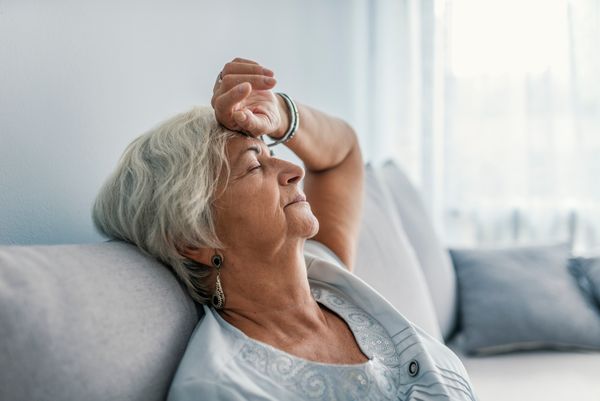As told to Shannon Shelton Miller
I was only 30 when I had an ischemic stroke that developed when blood clots traveled to my brain. Within hours, I went from completing work at home on my couch to hearing a doctor tell me I could die. People assume only older people have strokes, but no one is untouchable.
In late October 2018, I had intense headaches and nausea for four days. As a therapist and social worker, I had to attend multiple court cases during that time — I couldn't miss them because my clients were depending on me. But, on October 25, I left work early because I didn't feel well. I got home, took a bath and settled down to relax in a dark room. Then, like the workaholic I was, I got up after my nap, went to the couch and worked on my computer for a few hours.
I remember feeling a pop in the back of my head. It went off like a firework. For 10 seconds, I was completely frozen. I tried to move, and I only remember throwing my laptop across the room and words coming out of my mouth completely garbled.
I learned later that what I experienced was a carotid artery dissection. The carotid artery is a main supply of blood flow, and the pop occurred when I shifted my body to relieve tension. After the dissection, my body tried to help by making my blood clot, but when blood clots traveled to my brain, they caused me to have a stroke.
I'm so thankful that my husband was home and sitting near me so he could see what was going on. I somehow managed to say "hospital," and he drove me to the nearest emergency room. I was still able to move and talk, but I clearly remember trying to enter my social security number during the check-in process. Not only did I not know it, I couldn't recognize the numbers.
The doctor who examined me realized I was having a stroke and said I would have to go to another hospital for surgery immediately. "Ok, my husband can just drive me," I responded. I was still so completely unaware of what was happening. The doctor responded very firmly that I needed to understand the seriousness of my condition and that I would be going in an ambulance right then because time was of the essence. I could die if I wasn't seen immediately.

Hearing you might die at 30 years old just floors you. I underwent a three-hour surgery to get the clots removed from my brain. I underwent four more surgeries to repair my brain and spent four weeks recovering in the ICU. I was thankful to recover from my surgeries, but I had to regain everything I'd lost. At first, I could only move my eyes, and then I started to move my fingertips. I regained use of the right side of my body and had to relearn how to eat. Eventually, I began to move the left side of my body and then started practicing walking. It was a little over a month before I could finally speak.
Experts say the new baseline for stroke survivors appears about a year later. With my "new normal," people might see me now and think what I experienced wasn't too bad, but they weren't there during the daily occupational therapy, physical therapy and speech therapy appointments I attended. They didn't see the preschool and kindergarten workbooks and flashcards I had to use to learn how to read again.
I now have sensory processing disorders I didn't have before. I have to wear earbuds to drown out ambient noise in places where a lot of people are talking because I've become very sensitive to noise. My depth perception is often off, and once I bit the side of my mouth trying to eat. I also have aphasia, which affects my speech, and a memory processing disorder that causes me not to remember things as well as I used to.
After my stroke, I vowed that if I could learn to speak again, I'd be relentless in making sure others don't have to experience what I did. Women have a higher risk of stroke than men, and there are some actions people can take to reduce their risk. I talk to everyone I can about steps you can take to increase your chances of survival if you're having a stroke.
The acronym B.E. F.A.S.T. can help identify signs of a stroke:
B: Balance — Is someone struggling with balance or coordination?
E: Eyes — Is there evidence of vision loss or double vision?
F: Facial — Is one side of the face numb or drooping? Can the person smile?
A: Arm weakness — Can the person feel or raise their arms? Can the arms stay raised?
S: Speech — Is their speech slurred or are they having trouble speaking?
T: Time to call 911 — If any of these symptoms are present, get medical attention immediately.
Although I love what I do, my job can be pretty stressful and demanding. I was a self-proclaimed workaholic, always suffering from chronic headaches, stress and fatigue, but I just accepted it as part of my life. As women, we're often the caregivers for everyone around us. We can be focused on making sure everyone has what they need to the detriment of ourselves and our own needs. It's a dangerous mindset, and I know I often put my own needs on the backburner.
This year, I was named Mrs. Ohio International, and I'm using my platform to get this message out to the world. I have a new voice and people might have a more difficult time understanding me now, but I'm grateful I have the ability to speak. If I can save one life by sharing my story — even if my speech is a little funny when I share it — it's worth it for me to speak up.
- How to Reduce Your Risk for Stroke - HealthyWomen ›
- Stroke Awareness: Early Intervention Saves Lives - HealthyWomen ›
- Worried About Stroke? Know the Facts - HealthyWomen ›
- Stroke Symptoms Checklist - HealthyWomen ›
- Is Smelling Burnt Toast a Sign That You're Having a Stroke ... ›
- Stroke - HealthyWomen ›







